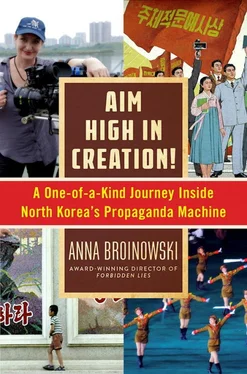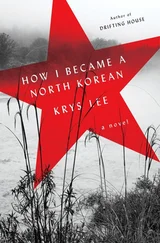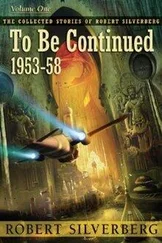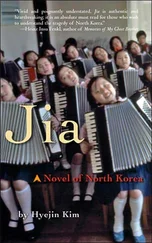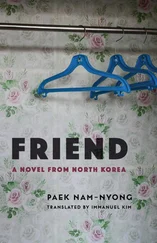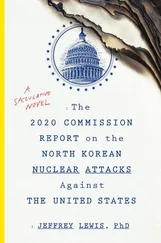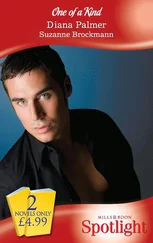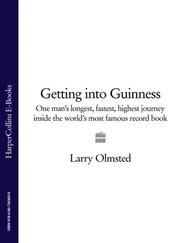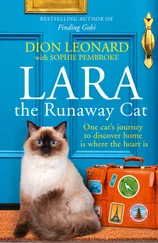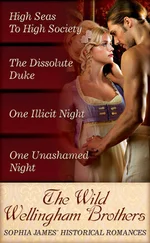That afternoon, as Mr. Pak walks me around the Pyongyang Studio, pointing out the offices, restaurants, crèches, and a building where filmmakers distil their own beer, it appears that life, for a dwindling elite at least, is still cushy. “You know what beer is, don’t you?” Pak asks playfully, the dappled light playing on his silver mane.
“Of course. It’s our national drink,” I say.
He fixes me with a look of intense curiosity. “Do you have many drunken people in Australia?”
“Being drunk is our national way of life,” I deadpan. “That’s why you won so many medals at the Olympics, and our swimmers bombed in the pool.”
Pak grins. He has enough English to know that I’m teasing him. He’s enjoying it. “DPRK came twentieth in the medal count. That’s not bad for a small country, is it?” he says—and leads me over to the ghostly streets of Kim Jong Il’s outdoor film sets. Now I’ve seen more than fifty North Korean movies, the plaster facades feel alive. “This village is modelled on the Yi Dynasty, from the 1400s,” says Pak—and I can see the black-clad ninja skittering across the eaves of the ancient temple, ready to spring on the heroic Hong Kil Dong.
“From here are the Japanese streets,” Pak continues, rounding a small hut to enter an urban streetscape circa 1931, covered in kanji. “This is what it was like under colonial rule. You can’t find houses that look like this any more, so with his thoughtful consideration, our Great General built this for us in 1974.” I stare at the shop fronts lined up in eerily silent rows. There’s the wooden gate where the mother in Sea of Blood shot the Japanese commander dead; there’s the cobblestoned square where the businessmen and prostitutes spat at Kotpun in Flower Girl . Hanging above the dusty windows are clumsily hand-painted ads, their once-vibrant colours faded grey. “Lion toothpaste,” says Pak, pointing to one. “If you brush your teeth with Lion toothpaste from an early age, you will be healthy. That’s what it says.”
Pak helped design these streets when he was a young man and hungry to impress Kim Jong Il. He points out the buildings with proprietorial pride: the “Meiji textile mill,” the “Fuji film shop,” the “Suntory whisky bar,” and a cafe advertising—of all things—the Japanese soft drink Calpis. “I didn’t know they made Calpis in the ’30s,” I comment, and Pak looks affronted: “All advertisements are exact reproductions from the original time. This set covers imperial rule from the 1920s to the 1950s. We change the signs, depending on which decade we’re filming.” I ask Nic to film the tattered facade of the Eiga cinema, which has a Charlie Chaplin poster above its eaves. Pak, who’s shot it himself many times, makes sure she’s using a wide-angle lens to capture it at its most impressive. “The king of comedy,” I say, managing to decipher the Japanese. “Do the Korean people like Chaplin?”
“Everybody likes Chaplin.” Pak shrugs. “These are the movies that were popular then. Look—there’s Blackbeard the Pirate directed by Raoul Walsh, starring Linda Darnell. And this one is Billy Wilder’s Seven Year Itch .” The posters are painted in sepia and mounted on warped wooden frames. Marilyn Monroe’s luscious pout reflects back at us from a muddy pool in the gutter. We continue up the cobbled street, our footsteps echoing inside the empty, neglected buildings.
Hundreds of movies may have been made here in Kim Jong Il’s heyday, but the place feels like a ghost town. It appears to have been dormant for some time. As if to confirm this, a beige cow appears from behind the “Asahi work boots” shop and walks slowly across the road, its neck bell swinging from side to side. “Oh look, a cow,” Pak says nonchalantly—and walks off to chat with Sun Hi while Nic trains her lens on this surreal image.
The cow clanks its way past Clark Gable and on to “Mitsubishi electrical parts,” followed by a man in a singlet and a line of skinny goats. We can hear Pak and Sun Hi chatting through the camera headphones: Mr. Wang has dropped the boom to take a call, but our Beijing radio mics are still in range. According to our Sydney translator, the conversation goes like this:
Pak: “Do you think Australian cows look like that?”
Sun Hi: “No, they have black-and-white ones. You know: milk cows, with spots.”
Pak (sighing) : “Marilyn Monroe had a voluptuous figure, you know. She did movies mainly to exhibit her body. She was very famous.”
Sun Hi: “Really?” (Lowering her voice.) “What nationality was she?”
Pak: “American, of course. There’s a rumour she had an affair with Kennedy.”
Sun Hi (gasping in amazement) : “Oh wow.”
Pak (annoyed) : “Haven’t they filmed enough of the cow?”
Nic and I look up from the lens to see Pak frowning at us, hands on hips. The afternoon is fading away, and Pak wants us to film the sets in a wide shot, in that brief window of magical light just before sunset, known to filmmakers the world over as “the golden hour.” Pak hurries us round the corner to 1950s Seoul: a hotchpotch of bars and massage parlours, with billboards of wasp-waisted dames holding martinis and cigarettes. “Look, there’s the ‘brothers’ bar,’” he says, and I’m struck by how innocent this take on Westernised vice is compared with the X-rated, drug-riddled free-for-all that Seoul’s red-light district has become. “This is South Korea during the American bastards’ occupation,” Pak explains helpfully.
“You’ve made it full of brothels and bars and massage parlours!” I challenge. “Is that because you want South Korea to look decadent?” Pak laughs: “It’s not all massage parlours—look, that sign says ‘ Samjung Trading, Daedong and Co .’ That is a chemicals manufacturer. There’s the ‘Office of Public Prosecution.’ You need all sorts of scenes for movies about Korea under occupation. We needed to create a variety of shops, and due to the hostility between the two Koreas, we can’t film in the South. Besides, you can’t see old shops like this in Seoul any more, thanks to modernisation.”
We stop under a shopfront displaying a torpedo-breasted woman reclining on a pink love seat. “That’s not a massage parlour,” says Sun Hi defensively. “The sign says: ‘ Female’s true attractiveness comes from the breasts .’ It’s a breast-enlargement cosmetic centre.” She flicks her ponytail, pleased to have backed up Pak. I wonder what Sun Hi would make of her cashed-up sisters in Seoul, forking out thousands of won to pump their chests full of silicon, widen their eyes, and lighten their skin. I could ask her in front of Pak, but with Q hovering next to Nic’s viewfinder, it’s too risky. Q may only say “yes” when spoken to in English, but he appears to understand a lot more. Probing Sun Hi about what she knows of plastic surgery, or anything else in South Korea, could compromise her in ways I don’t want to contemplate.
I follow Pak across a small square to a shack decorated with coyotes and tumbleweeds. New Popular Songs! Arizona Music Shop , the awning says. Pak studies it fondly: “I saw a photograph of a shop like this in a coffee-table book on America once. That’s why I chose it.” He turns to me, serious: “Anna, I didn’t intend to show that South Korea has an indolent lifestyle. We can’t make them—or any other place—look bad just because they are the enemy. I’d like you to understand that clearly.”
I nod, fighting the impulse to point out this is not what Kim Jong Il instructed in his manifesto. Pak seems troubled behind his urbane smile. I have several days of filming left with him, and I can’t afford to blow it. So I walk to the shop next door, the “Migrants’ Information Centre.” The sign invites Brazilians, Germans, and Canadians to come inside for travel advice. I step in and peer at Pak through the plywood window, making what I hope is an acceptable joke: “Can Australians use this place? I want to migrate to the DPRK.”
Читать дальше
